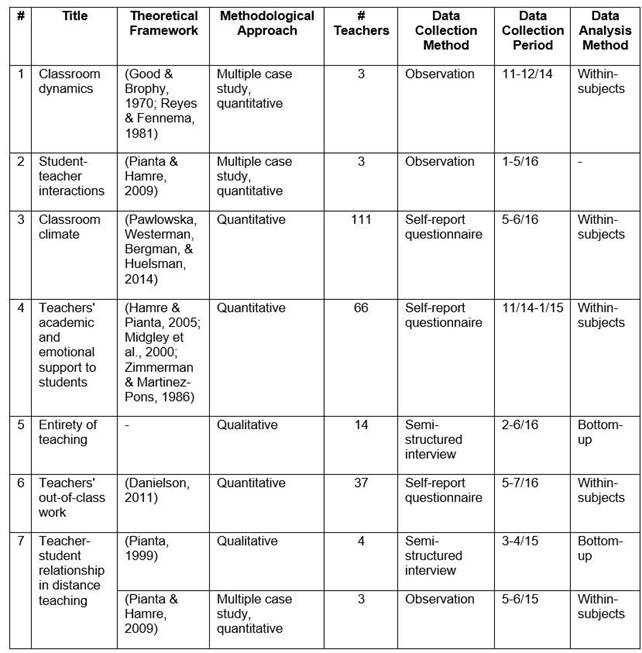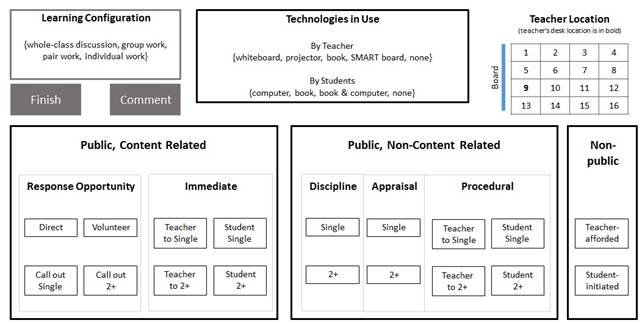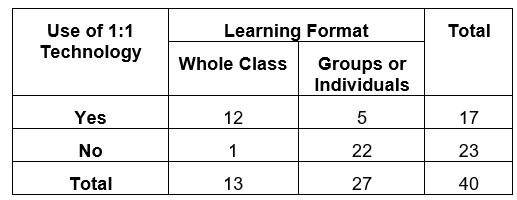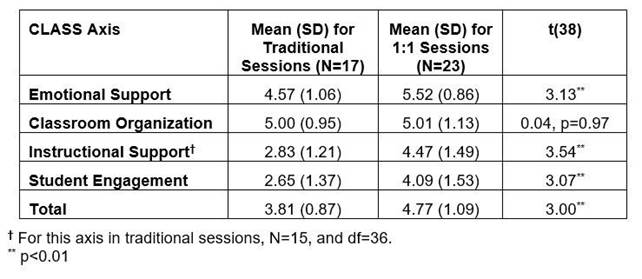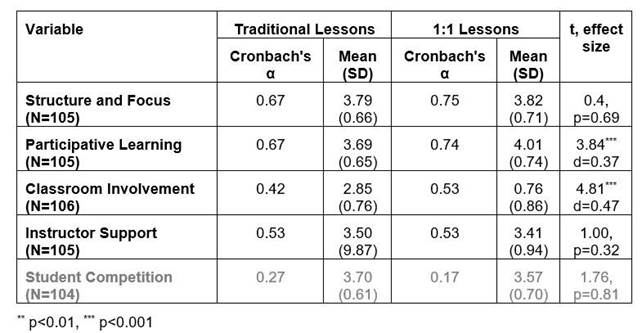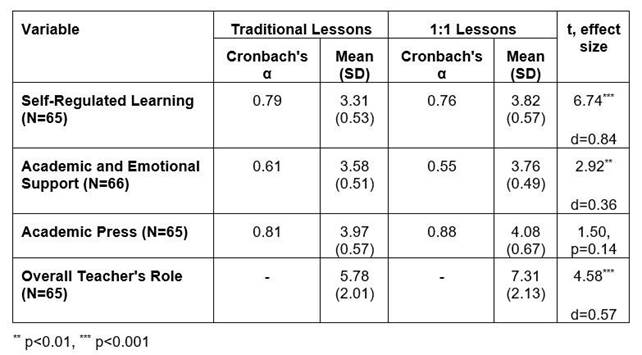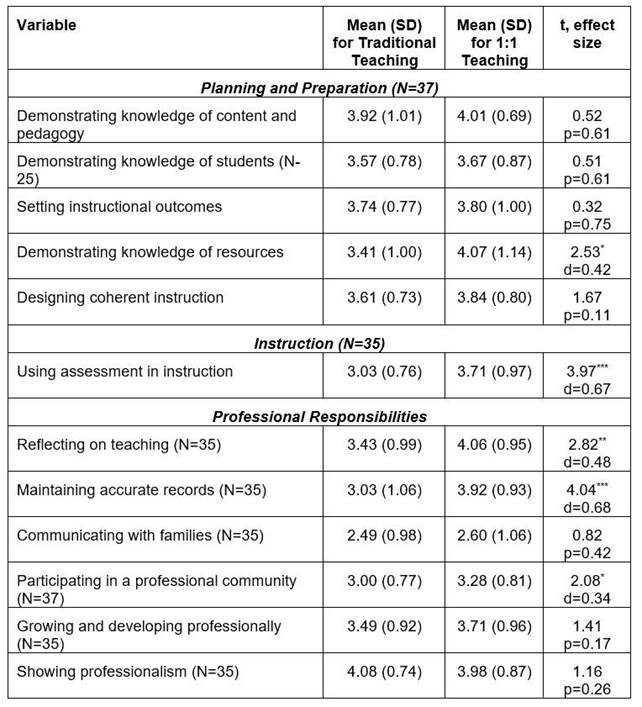Introduction
Student-teacher interpersonal relationships are key to students' academic, social and emotional development, and consequently may affect the social and learning environments of classrooms and schools (Birch & Ladd, 1998; Cornelius-White, 2007; Gregory & Weinstein, 2004; Hamre & Pianta, 2001, 2006a; Sabol & Pianta, 2012). Strong, supporting student-teacher relationships might promote students' feelings of safety, security and belongingness, and may eventually lead to higher academic achievements. In contrast, conflictual relationships might place students in situations where they do not feel connected to their school's academic and emotional resources, and may lead them to failure (Hamre & Pianta, 2006b; Roorda, Koomen, Spilt, & Oort, 2011). Importantly, positive or negative teacher-student relationships might also influence teachers' well-being and professional development (Hamre, Pianta, Downer, & Mashburn, 2008; O’Connor, 2008; Roorda et al., 2011; Spilt, Koomen, & Thijs, 2011; Yoon, 2002). As such, teacher-student relationships are considered an integral part of classroom research (Pianta & Hamre, 2009).
Teacher-student relationships are defined by a few dimensions, which indicate the complex nature of this construct. Usually, these relationships have positive and negative dimensions, often termed "conflict" and "closeness"/"satisfaction", respectively. Additionally, there is a dimension that refers to the actual assistance students get from their teachers (not necessarily academic, might also be personal, emotional, etc.), often termed "dependency" or "instrumental help" (Ang, 2005; Pianta, 1992).
Like any other interpersonal relationship, the teacher-student relationship is affected by a plethora of factors, including personal (of both the student and the teacher) and contextual. As new technologies become an integral part of schools, overall classroom dynamics might change dramatically, potentially affecting teaching styles at large (Dipietro, 2010; Ertmer, 2005; Hartley, 2007; Tucker, 2014; Webb & Cox, 2004); consequently, teacher-student relationship might be affected. Conceptualizing student-teacher relationships, Hamre & Pianta (2006b) noted that in addition to individual features, three components shape the relationships between students and teachers: perceptions and beliefs, information exchange processes, and external influence. These components are highly relevant to the technology-enriched classroom. Using digital devices for teaching and learning serves as an external influence on the classroom, specifically impacting information exchange; importantly, it is also accompanied-that is, affected-by perceptions and beliefs (Celik & Yesilyurt, 2013; Dündar & Akçayir, 2014; Kale & Goh, 2014; Liaw, Huang, & Chen, 2007; Wang, 2002). Therefore, it is important to analyze teacher-student relationships in the context of using computers in the classroom.
One-to-one (1:1) computing programs-in which each student (and the teacher) has an Internet-connected digital device-have become very popular world-wide, with millions of computers in use under these initiatives (Richardson et al., 2013; Severin & Capota, 2011). The two most common models to the implementation of such program are: a) School-owned computers (usually laptops or tablets), which are bought in a limited number and can serve teachers based on availability. When not in use, the devices are kept in a charging cart; and b) Bring Your Own Device (BYOD), where students may access their device continuously in school and at home.
With regards to academic performance, such programs often show some benefits for students (de Melo, Machado, & Miranda, 2017; Lei & Zhao, 2008; Penuel, 2006; Zheng, Warschauer, Lin, & Chang, 2016). However, looking beyond achievements, and considering the teachers' point of view, these programs may change the ways teaching is handled. Specifically, they may alter teaching strategies, classroom management, teacher-student interactions, and teachers’ perceptions of their role (Spires, Oliver, & Corn, 2012). These, in turn, are closely related to the teacher-student relationship (Khan, 2013; Oren & Jones, 2009; Rudasill, 2011; Sun, 2012; Wubbels & Brekelmans, 2005). Additionally, implementing 1:1 computing programs might influence the student-teacher relationship as these initiatives are aimed at moving towards a learner-centered approach to learning (Carey & Grant, 2015; Rosen & Beck-Hill, 2012; Spires et al., 2012; Zheng et al., 2016).
Following that, the current paper will present empirical evidence from six studies of the impact of 1:1 computing programs on various aspects of classroom dynamics and teachers' perceptions, which might affect the teacher-student relationship. All these studies refer to technology-enriched face-to-face teaching. Finally, another study presented herein discusses the student-teacher relationship in online teaching, as it sheds further light on the topic. In the following sections, we will shortly present each of these studies separately, and then will discuss the picture that emerges from their findings taken together.
The Studies
The seven studies presented herein were carried out between 2014-2016 across Israel and used various methodologies. The quantitative studies were mostly designed adopting a within-subject approach, assuming that every teacher has their own educational agenda, their own practices of teaching, and their own way of handling technology in teaching. Details about the studies are summarized in Table 1.
Study 1: Classroom Dynamics
The main objective of this study was to analyze classroom dynamics-specifically instructional strategy, teacher's location and teacher-student interactions-in the one-to-one classroom. We developed a mobile app for data collection, which allowed us to easily record fine-grained data in the field and to have it ready for analysis once the observation was over.
Variables and Tools. We analyze teacher-student interactions based on Good and Brophy's (1970) observation protocol, and considering its modification by Reyes and Fennema (1981); originally formulated to serve for classroom observations, these protocols refer to dyadic teacher-student interactions, and help in coding each such interaction based on a pre-defined set of categories. Drawing from these, we defined an observation protocol for coding every interaction between the teacher and a student or a group of students, in the context of the technology-enriched classroom. Each such interaction has been coded as one of the following:
− Content-Related Interactions
▪ Response Opportunity. A response opportunity is a public, content-related attempt by an individual student or a group of students to deal with a question posed by the teacher.
▪ Teacher's Comment. A teacher's comment is a public, content-related interaction initiated by the teacher not in a form of a question.
▪ Student's Comment/Question. A student's comment/question is a public, content-related interaction initiated by a student or a group of students that is not preceded by a teacher's question.
− Behavioral Interactions. These are public, non-content related teacher's comments, either an appraisal or discipline related.
− Procedural Interactions. These teacher-initiated interactions are public, non-content related; they are related to student- or class management, e.g., permission, supplies, or equipment.
− Non-Public Interactions. Non-public interactions are held privately between the teacher and one or more students. As such, we assume not being able to further categorize them.
Additionally, learning configuration was documented (whole class discussion, group work, pair work, individual work, or arrangement), as well as teacher's location (marked on an imaginary 4x4 division of the classroom). For the purpose of this study, we developed a mobile-app, using which the observer can conduct the observation efficiently; every occurrence is easily documented with a hit of a button (Hershkovitz, Merceron, & Shamaly, 2015). A scheme of the main observation screen in this app is presented in Figure 1.
Process. Class observations took place during November-December 2014 and March-June 2015. We made nine visits to the school, during which we repeatedly observed three classes; each teacher (and her students) was observed at least 3 times during traditional classes (with no use of computers at all) and at least 2 times in 1:1 classes (during which tablets were available to be used on a one-to-one basis, but were not necessarily used throughout the class). The observer was located at the back of the classroom, from where he could watch the whole class.
Population and Data. Participants were three 5th- and 6th-grade English female teachers in a Druze village in the north of Israel, and their students. These teachers used tablets for teaching purposes for the first time during the school year 2014/15 (when the study was conducted). Each of the teachers was observed for an overall of 5-6 classes of 45-50 minutes each. Overall, 3,147 student-teacher interactions were recorded during 17 classes.
Main Findings. For each teacher-noted here as AM, RI, AR-we compared their own behavior during traditional and 1:1 classes. The average time spent on tablets in 1:1 classes was 69.2% for AM, 71.2% for RI, and 80% for AR.
Interestingly, each of the teachers had significantly changed the way they were handling 1:1 classes compared to traditional classes, however these changes were manifested differently. AM had maintained a similar level of whole-class discussions while extending pair-work time on the account of individual work; RI had somehow reduced the overall whole-class discussion time, switching from allocating time to individual work to allocating time to pair work; and AR dramatically reduced the whole-class discussion time, allocating it to individual work. Findings are summarized in Table 2.
Table 2: Average time ENT#091;secENT#093; for each learning configuration in traditional and 1:1 classes
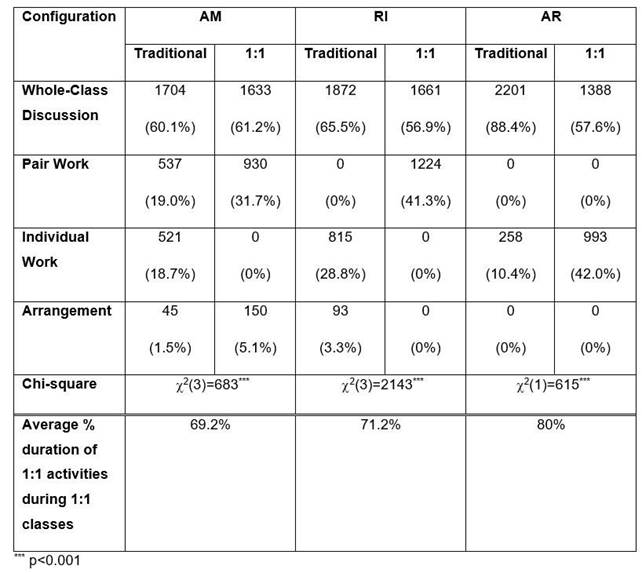
Overall, the teachers spent most of the class time near their desk and the whiteboard. During 1:1 activities, two of them (AM and RI) lessened the time spent in this "safety zone" and reached to other regions. The third teacher (AR) used 1:1 activities to spend more time at her desk (checking homework and calling students for private conversations, as was noted in the observation file). Results are summarized in Figure 2.
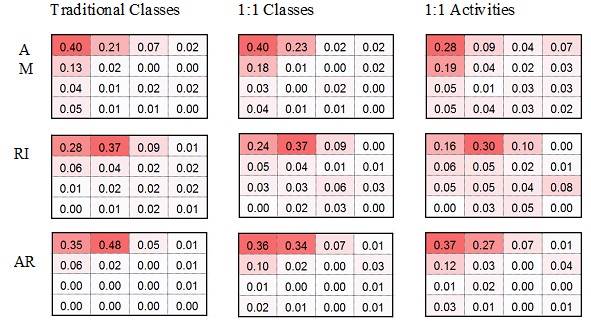
Figure 2: Heat maps of teacher's location during lessons with/without tablets and during activities in which tablets were in use. The white board is located in the top-middle locations; the teacher's desk is located in the top-left corner
For two of the teachers, we found significant differences in frequencies of interaction types between 1:1 and traditional classes, however, in different directions. AM had suggested much less response opportunities and more non-public interactions in the 1:1 classes compared to the traditional classes (the latter is consistent with her being physically closer to more students during 1:1 activities compared to traditional classes, as mentioned above), while RI demonstrates an opposite pattern, suggesting more response opportunities and having less non-public interactions during 1:1 classes compared to traditional classes. These differences are not in line with a recent study that found no significant difference in teacher-student interaction with the use of iPads (Leslie & Johnson-Leslie, 2013), probably as a result of the analysis enabled by our data granularity.
Summary. Findings suggest that the use of tablets increased the potential for close, non-public student-teacher interactions, as it extended the time allocated to learner-centered activities (individual and pair work). However, this potential is not always satisfied, as teachers may use the time spent by students on independently undertaken activities to work on their own tasks instead of "being there" for their students.
Study 2: Teacher-Student Interactions
The main objective of this study was to explore how technology-enhanced classrooms are characterized by multiple dimensions of student-teacher classroom interaction that are linked to student achievement and development.
Variables and Tools. We used the CLASS framework for secondary schools (Pianta & Hamre, 2009) and followed its observation protocol to measure four domains of student-teacher interactions: emotional support (e.g., positive climate, teacher sensitivity), classroom organization (e.g., behavior management, productivity), instructional support (instructional learning formats, quality of feedback), and student engagement. Each domain is scored separately on a 7-point Likert scale, the overall grade is the mean of the four domains' values.
Process. Observations took place during January-May 2016. During four visits to the school, we repeatedly observed six classes, with an overall of 17 lessons (either single, 45 minutes long, or double, 90 minutes long) and 40 within-lesson-sessions were observed. A 45-minute lesson included two observation cycles, a 90-minute lesson included three observation cycles. Each class was observed between 2-5 times, the lessons observed demonstrated different levels of technology use (e.g., using a projector, using desktops in a computer lab, or unrestricted use of mobile devices). The observer was located at the back of the classroom, from where he could watch the whole class.
Population and Data. Participants were three 7th-, 8th-, and 9th-grade teachers (denoted by AN, RA, and RO) and their students (number of students in a class during observations varied between 7-33), in a school located in a big city in the center of Israel. Topics taught were mostly from the Humanities (Bible, Israeli Culture, and History), with one of the participating teachers (RA) working with a small, multi-grade group on various projects. In the school year when this study was conducted, the participating teachers were leading a new technology-enhanced, project-based approach to learning.
Main Findings. Optimally, we would take a within-subject approach here as well. However, due to the relatively low number of observations for each teacher (6 lessons and 14 sessions for AN; 2 lessons and 6 sessions for RA; and 7 lessons and 20 sessions for RO), we will use the whole data. First, we compare the teaching strategies during sessions in which 1:1 technology was used with traditional sessions (including sessions where only a projector was used). Running a cross tabulation analysis between strategy of learning-either whole-class learning or working in groups/individually-and the use of 1:1 technology, we find a significant change in the teaching strategies, with more learner-centered activities during the technology-enriched sessions (χ2=19.6, p<0.01). Findings are summarized in Table 3.
Comparing the CLASS values between technology-enhanced and traditional sessions, we get a significant increase in all but one of the axes. This means that emotional support, instructional support, and student engagement were higher in the 1:1 sessions compared to the traditional ones. The first two support-related dimensions are related to the very definitions of teacher-student relationship (Ang, 2005; Pianta, 1992), and the third is associated with teacher-student relationship (Roorda et al., 2011). Hence, the observed improvements are indicators for improvement in teacher-student relationships. Findings are summarized in Table 4.
Summary. Findings from this study suggest that during 1:1 sessions, learning was more learner-centered, and the overall teacher-student relationship was more positive than during traditional sessions.
Study 3: Classroom Climate
This study aimed at identifying changes in classroom environment during 1:1 lessons, compared to traditional teaching.
Variables and Tools. The dependent variable was classroom environment, as used in Pawlowska et al. (2014). Based on this framework, classroom environment is characterized by five dimensions: structure and focus (example item: "Almost all class time is spent on discussing the course material"), participative learning ("New and different ways of teaching are tried very often in this course"), classroom involvement ("Students sometimes present something they've worked on to the class"), instructor support ("The instructor takes a personal interest in students"), and student competition ("Students try hard to get the best grade"). Our self-report questionnaire for teachers is an adapted version of Pawlowska et al.'s CES (Classroom Environment Scale), and has 16 items to be ranked on a 5-point Likert scale. In addition, we collected data about the actual use of the portable devices in the classroom: frequency of use throughout the school year, extent of use when used in lessons, and types of activities facilitated by these devices.
Process. Data was collected during May-June 2016 via pen-and-pencil self-report questionnaires. Participants were recruited in three public schools in cities in the center of Israel. Participants were teachers who during the 2015/6 school year had taught in both traditional and 1:1 settings. The research questionnaire was designed so that first the participant chose a subject she or he is teaching, and then ranked each item twice-regarding 1:1 lessons and traditional lessons on this subject.
Population. Overall, 111 middle and high school teachers had filled out the research questionnaire. Participants' ages ranged between 24-58 y/o (M=38.1, SD=7.0, N=107), teaching experience ranged between 1-37 years (M=14.6, SD=7.6, N=108), with 80% females (86 out of 108; 3 participants had not filled out the gender field) and 20% males (22 out of 108).
Main Findings. About 28% of the participants (31 out of 111) stated that they never or only seldom use mobile devices in their lessons, 44% (49 out of 111) stated that they often use them, and 28% (31 out of 111) stated that they almost always use them.
When asked about the time of the 1:1 lessons that is usually dedicated to computer-related activities, 23% of the teachers (25 out of 110) mentioned that they use the computers for less than half of the lesson, 46% (50 out of 110) said that they use them for about half of the lesson, and 21% (35 out of 110) stated that they use them for more than half of the lesson.
We provided the participants with a list of types of activities, and they were asked to mark whether they implement any of these activities during the 1:1 sessions. The activities that were scored by more than half of the teachers were watching movies (72%, 79 out of 110), practicing (71%, 78 out of 11), and using a digital book (53%, 58 out of 110). Other activities included playing games (43%, 47 out of 110), collaborative learning (41%, 45 out of 110), research-based learning (26%, 29 out of 110), information seeking (19%, 21 out of 110), and other activities (11%, 12 out of 110).
One of the components of CES (student competition) was found to be non-reliable (testing using Cronbach's alpha), therefore was removed from the analysis. Of the remaining components, when comparing 1:1 with traditional lessons, we found that participative learning and classroom involvement were significantly higher in the 1:1 lessons, with medium-high effect sizes, and that no differences were found in structure and focus and in instructor support. Findings are summarized in Table 5. Interestingly, when considering only those teachers who used the computers at the highest frequently ("Almost always", N=27), the structure and focus component was also found significant, with higher mean in the 1:1 lessons (M=4.18, SD=0.53, compared with M=3.91, SD=0.65), with t(26)=2.34, at p<0.05, with a medium-large effect size, Cohen's d=0.45.
Summary. As findings from this study suggest, most of the teachers in schools that implemented 1:1 computing programs did use the computers frequently and extensively, however, they did not necessarily promote meaningful learning using the computers. Participative learning and classroom involvement were reported as higher in the 1:1 lessons, and structure and focus was reported higher for teachers who used computers most frequently.
Study 4: Teachers' Academic and Emotional Support to Students
The main objective of this study was to explore teachers' perceptions of their role in promoting academic and emotional aspects of learning in 1:1 classes, compared to traditional teaching.
Variables and Tools. In this study, we measured three variables. First, self-regulated learning, that is, the extension to which learners select, structure, and create social and physical environments that optimize learning; this construct was measured using a shorter (8 out of 18 items) adapted version of the Rating Student Self-Regulated Learning questionnaire (RSSRL, Zimmerman & Martínez-Pons, 1988); example items: "The students express interest in the activity", "The students solicit further information regarding my feedback to their work".
Second, we measured instructional and emotional support in learning, based on Hamre and Pianta's (2005) COS-1 Ratings of Emotional and Instructional Climate. This rating is composed of a few constructs of instructional support, e.g., evaluative feedback, or encouragement of child responsibility, and emotional support, e.g., teacher sensitivity, positive climate, or intrusiveness (reversed), each of which is described at its high end. Based on these constructs, we drew up a self-report questionnaire, converting each construct description to an item (a total of 10 items); example items: "I encourage my students to engage in conversations and expand on their ideas and perceptions of events" (instructional conversation, under instructional support), "The planning and running of the activity is guided by the students' needs, moods, interests and capabilities" (teacher sensitivity, under emotional support).
Lastly, we measured teachers’ perceptions of academic press, that is, of how they press their students for understanding. This variable was measured using an adapted questionnaire, based on the Academic-Related Perceptions, Beliefs, and Strategies: Academic Press scale of the students' version of Patterns of Adaptive Learning Scales (PALS, Midgley et al. ENT#091;2000ENT#093;), with 7 items; example items: "I encourage my students to do thoughtful work", "When my students are working out a problem, I tell them to keep thinking until they really understand". All the questionnaires' items were ranked on a 5-point Likert scale.
Additionally, a single item was added to measure teachers' perceptions of their role on the axis between "sage on the stage" and "guide on the side" (King, 1993), on a 10-point Likert scale.
Process. Data was collected during November 2014-January 2015 via both pen-and-pencil and computer filled out self-report questionnaires. Participants were recruited online (via personal and professional mailing lists, as well as via social networking sites) and in schools and centers for teachers' professional development. Participants were teachers who during the 2014/5 school year had taught in both traditional and 1:1 settings. The research questionnaire was designed so that first the participant chose a subject she or he is teaching, and then ranked each item twice-regarding 1:1 lessons and traditional lessons on this subject.
Population. Overall, 66 middle and high school teachers had filled out the research questionnaire. Participants' ages ranged between 23-63 y/o (M=43.5, SD=10.0, N=65), teaching experience ranged between 2-42 years (M=17.0, SD=10.6, N=65), with only 3 males and 62 females (one participant did not fill out the gender field).
Main Findings. As mentioned above, a within-subject approach was followed when designing this study. Therefore, we compare the variable values of 1:1 lessons with traditional lessons (for the same subject taught). Findings suggest that the participating teachers ranked their academic and emotional support and their students' self-regulated learning significantly higher in 1:1 lessons compared to traditional lessons, with high and medium effect sizes, effectively. Teachers' academic press was not found to be significantly different between these two settings.
Overall, teachers perceive their role significantly higher on the "sage on the stage"-"guide on the side" axis in 1:1 lessons, compared to traditional lessons, with a medium-high effect size. Findings are summarized in Table 6.
Summary. One-to-one lessons facilitated more learner-centered learning, compared to traditional lessons, including better academic and emotional support. These differences in teachers' role in 1:1 settings may promote teacher-student relationship at large.
Study 5: Entirety of Teaching
The main goal of this qualitative study was to explore teachers' perceptions of the various implications of 1:1 computing programs on the entirety of teaching. Some themes that were identified in this study are relevant to student-teacher relationships.
Methodology. Data was collected via semi-structured interviews with teachers. The interview protocol included four broadly phrased questions, which guided the interviewer. The teachers were asked about the implications of using 1:1 computing programs, implementation in their classes, lesson planning, teaching and learning during lessons, classroom management, and students' evaluation. For each topic, the interviewees were asked to specifically refer to 1:1 lessons, and then to compare them to traditional lessons.
Process. Participants were recruited via the researchers' personal networks and were interviewed in a location of their choice, during February-June 2016. Interviews-14 lasting 54 minutes-were recorded, and then fully transcribed. The transcriptions were analyzed following the conventional qualitative analysis approach, where coding categories are derived directly from the text data (Helgevold & Moen, 2015) for identifying themes, with a basic analysis unit being a statement.
Population. Fourteen 29-58 y/o elementary and middle school teachers (12 females and 2 males) participated in this study. Participants were teaching in public schools in the center of Israel and, had 1-34 years of teaching experience and 1-12 years of experience in using computers in the classroom. All of the participants incorporated to some extent 1:1 computing in their teaching and had been trained in the use of information and communication technologies (ICT) in the classroom as part of their professional development.
Main Findings. Overall, six categories were identified, some of which include a few themes. Those themes that are most relevant to student-teacher relationships are presented herein along with some examples of participants' statements:
−1:1 lessons are characterized by more learner-centered activities, compared to traditional lessons. "When I prepare a lesson in which mobile computers are used, frontal instruction is minimal, say 10 minutes, no more than that, in order to allow students more time with computers" (T5, Female, 54 y/o).
−:1 lessons-more than traditional lessons-are aimed at the development of an active and independent yet collaborating student. "I always love to incorporate some collaborative learning during 1:1 lessons…. It is very very important to me that every lesson includes a tool that allows students to express themselves" (T11, Female, 46 y/o).
−Less discipline issues are presented in 1:1 lessons than in traditional lessons; this is a result of: a) Enforcing the non-use of computers when classroom discussions are taking place; and b) Screens keeping the kids fascinated when being used. "There are clear rules - when the teacher says to turn off the laptops screens, then everybody turns them off. It's just like closing books and notebooks" (T2, Female, 48 y/o); "I don't have chitchatting problems in 1:1 lessons, they are using their computers, focused" (T12, Female, 53 y/o).
−1:1 lessons enable more interactions with students than traditional lessons. " During frontal instruction time there is a very specific kind of interaction, and then when the students start working with computers I'm free for most of the lesson to approach the groups, to lead a group" (T6, Female, 47 y/o); "When the kids are working with computers, I am walking around among them and trying to help those who need help. I can simply reach all students, which I cannot do in traditional lessons" (T5, Female, 54 y/o).
−1:1 lessons are more enjoyable than traditional lessons. "The kids have much more fun doing computerized tasks" (T4, Female, 31 y/o); "Mathematics class has become a class that the students really love, it is not as terrifying as it used to be" (T13, Female, 58 y/o);
Summary. Overall, the narrative identified in this study is one that characterizes 1:1 lessons as catalysts for enjoyable, engaging, active learner-centered activities, which allow the teacher to successfully interact with the students-more than traditional lessons.
Study 6: Teachers' Out-of-Class Work
The main objective of this study was to study the effects of using 1:1 computers in the classroom on the teacher's role outside of the classroom.
Variables and Tools. Danielson's (2011) Framework for Teaching defines the components of teaching in three domains-Planning and Preparation, Classroom Environment, Instruction, and Professional Responsibilities-each of which is then described by a few features. Danielson's evaluation practice is based on defined indicators that are detailed on a scale between "Ineffective" to "Highly effective". Our variables are based on the three domains, and on their respective features-that do not explicitly refer to the classroom. For each feature, we formulated a few items, based on the "Highly effective" indicators of this feature.
Overall, we defined 12 variables (which refer to Danielson's features) in 3 categories (which refer to Danielson's domains). Consequently, the research questionnaire consisted of 44 items on a 5-point Likert scale. All of the questionnaire parts were found to be highly reliable, as summarized in Table 7.
Process. Data was collected during May-July 2016 via computer filled out self-report questionnaires. Participants were recruited online (via personal and professional mailing lists, as well as via social networking sites). Participants were teachers who during the 2015/6 school year had taught in both traditional and 1:1 settings; they were first asked to think about both teaching settings, and then rank each item twice-regarding 1:1 lessons and traditional lessons.
Population. Overall, 37 middle and high school teachers filled out the research questionnaire. Participants' ages ranged between 27-34 y/o (M=36, SD=6.8), teaching experience ranged between 1-25 years (M=7.2, SD=7.0), with 38% females (14 of 37) and 62% males (23 of 37).
Main Findings. Under the Planning and Preparation domain, Demonstrating Knowledge of Resources was found to be significantly higher for 1:1 teaching than for traditional teaching, with a medium to high effect size. The other features-regarding teachers' knowledge of teaching and of their students-did not differ between the two teaching settings.
The single feature of the Instruction domain, namely, using assessment in instruction, was found to be significantly higher for 1:1 teaching than for traditional teaching, with a high effect size.
Under Professional Responsibilities, Using Assessment in Instruction, Maintaining Accurate Records, and Participating in a Professional Community were found to be significantly higher for 1:1 teaching than for traditional teaching, with high effect sizes. That is, differences were found in the ways teachers manage their teaching and participate in professional community; differences were not found in the way teachers communicate with students' families and in their overall professionalism.
Summary. Findings from this study suggest that regarding 1:1 teaching, compared with traditional teaching, teachers perceive that they benefit from a wealth of resources, but do not, however, prepare themselves differently for classes; they also benefit from having more ways to assess their students. They manage their teaching better, and develop better professionally, mostly in the community-related sense.
Table 7: Details about the research questionnaire for Study 6, based on Danielson's (2011) Framework for Teaching
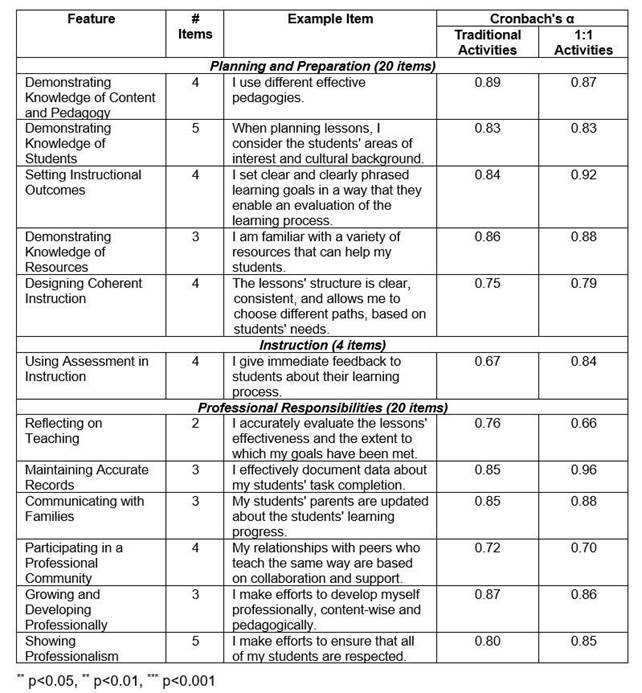
Study 7: Teacher-Student Relationship in Distance Teaching
The main objective of this qualitative study was to examine teacher-student relationships in distance teaching.
Methodology. Data was collected via semi-structured interviews with Israeli teachers who teach in two settings: synchronous, online teaching of US-based classes, and traditional classes (in Israel). We were following the Teacher Relationship Interview protocol (TRI) (Robert C. Pianta, 1999). This interview protocol aims at collecting data about the relationship of teaching to a single student; at the beginning of the interview, the interviewee is asked to choose one of her or his students and to refer to this particular student, and to some specific instances in their relationship. Interviews were recorded, and then fully transcribed. The transcriptions were then analyzed following the conventional qualitative analysis approach (Helgevold & Moen, 2015) for identifying themes, with a basic analysis unit being a statement.
In addition, data was collected via observations on the participating teachers' recorded lessons that were taking place as part of their distance teaching. Observations followed the CLASS-S protocol (Pianta & Hamre, 2009), in which four domains were coded on a 1-7 scale: Emotional Support, Classroom Organization, Instructional Support, and Engagement.
Process. Each teacher was interviewed twice (in a row), where one interview focused on the distant class this teacher was teaching, and the other on the traditional class. Interviews took place between March-April 2015. In addition, recorded online lessons of three of the participants were observed and coded during May-June 2015 (about four classes were observed for each teacher).
Population and Data. Participants were 4 Israeli middle school teachers (3 females and 1 male), ages 39-50 y/o. Participants were teaching online synchronous classes to US-based classes, and additionally teaching traditional classes in Israel. Participants had 15-35 years of teaching experience and 3-5 years of online teaching experience. Interviews were 37-61 minutes long.
Main Findings. In the analysis of the interviews, we came up with 4 main themes regarding the teacher-student relationship, as can be seen in the statements below:
1. When choosing the student from the online class, teachers referred to a highly academically motivated student with whom they have an intellectual connection, whereas from the traditional class, they chose a lowly academically motivated student, a connection that had arisen from that student’s distress. "If there's something she doesn't understand, then she's writing to me, asking what she can do" (T3, female, 39 y/o, regarding the online class student); "Many hours of meetings and talks with teachers didn't bring about the expected result, mainly with regards to her motivation and cooperation" (same teacher, regarding the traditional class student).
2. Only with reference to the student from the online class, did teachers mention instances of unusual communication. "Immediately when she doesn’t understand something or something is going to be late or she really loved something, she will write back to me, she will send an email… she will let me know how she feels, what's going on in her life " (T4, female, 62 y/o, regarding the online class student); " his writing is so immediate and impulsive that it brings him alive, you know, because so often there are exclamation points and five question marks, so he’s really present in his written communication" (T2, female, 62 y/o, regarding the online class student).
3. Regarding online teaching, teachers used the term "care" mostly in the context of academic issues, while in traditional teaching, teachers used the same term for emotional issues. "She knows that I care and that my goal is for her to love class and to learn something" (T4, regarding the online class student); "because of our respect for each other, we really cared about each other, we were very close" (same teacher, regarding the traditional class student).
4. The online teaching platform is focused on academic issues, it does not strengthen emotional bonds. "I think that we ended up in our relationship just by the way it was designed, it was a very transactional relationship, as in: I was hired to present material, he was there to learn from this material, and we concluded our business" (T1, male, 50 y/o, regarding the online teaching student).
Overall, participating teachers regarded their relationship with the online class student as academically focused, while the descriptions of their relationship with the traditional class student involved a broader array of emotions. One of the participants brilliantly summarized it when referring to the two students he chose to talk about: Tyler, the traditional class student, and Owen, the online class student. "I think of Tyler1. the person and of Owen the student", the participant said (T1).
The analysis of the recorded online lessons, using the CLASS-S observation protocol, adds to our understanding of these themes. We compare the scores from this study to average scores obtained in a large study that used the same framework to observe traditional classes of 82 middle and high school teachers from 40 schools in the US (Gitomer, Bell, Mccaffrey, Hamre, & Pianta, 2014). As can be seen in Table 9, Instructional Support was significantly higher and Classroom Organization was significantly lower in our study than in Gitomer et al.'s. However, no clear differences can be observed in Emotional Support. The latter might be surprising considering the interviews' analysis, however we should recall that the participants were interviewed about a single student while the observation took into consideration the entire class.
Summary. Based on perceptions of teachers who teach in both online and traditional settings, the student-teacher relationship in online teaching is more academically focused and less person-focused than in face-to-face teaching. Observational analysis support the former but not necessarily the latter.
Table 9: Comparing CLASS-S scores between our study (online classes) and Gitomer et al.'s (2014) (traditional classes)
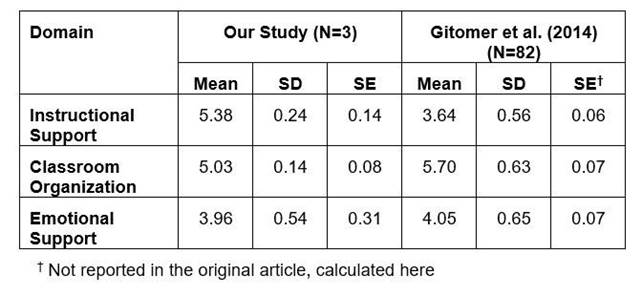
Discussion
This paper presents six studies of the impact of one-to-one computing programs on various aspects of teaching which are closely related to teacher-student relationships. A seventh study explored student-teacher relationships in online teaching. Looking beyond achievements, one-to-one computing programs-where every student is using an Internet-connected portable computer (and in many cases this device will go home with the student, that is, will be available for her or him at all times)-have the potential of dramatically changing the ways teachers teach and students learn (Spires et al., 2012). However, although such programs have been implemented in many countries and with millions of students for over a decade-almost 9 million computing devices for students around the world have been counted a few years ago in an effort to map the large-scale 1:1 initiatives (Richardson et al., 2013)-this far-fetching potential has not yet been fulfilled (Jenni & Mikko, 2013). Indeed, some schools had dropped such programs after a few years of implementation (Hatakka, Andersson, & Grönlund, 2013; Hu, 2007).
On the other hand, even though the modes of teaching and learning have not undergone dramatic changes, successful implementation of one-to-one programs has led to satisfying results besides improving achievements. Student engagement, students' research skills and technology proficiency, as well as teacher practices-all were shown to be improved as a result of a one-to-one computing program (Bebell & Kay, 2010; Lebo, 2014; Lei & Zhao, 2008).
Some preliminary evidence advises us that student-teacher relationship might be also improved when implementing one-to-one computing programs in schools (Danielsen, 2009; Higgins, 2015; Pettit & McManus, 2014; Pischetola, 2010). Overall, the studies presented here agree with such a claim. As findings from our studies suggest, one-to-one computing programs, compared with traditional teaching, are characterized by: a) Closer, more personal teacher-student interaction in the classroom (Study 1, Study 5); b) Taking a more learner-centered approach (Study 1, Study 2, Study 3, Study 4, Study 5); c) Better teachers' academic and emotional support to students (Study 4); and d) More effective, more collegial teaching management (Study 6). These aspects of learning and teaching are directly associated with teacher-student relationship, as we will now explain.
Teacher-student interactions are key to most school-taught lessons, and their importance have not dimmed even in distance learning (Holmberg, 1983). Clearly, learning with computerized devices in the classroom, specifically when every student has their own device, might change the ways teachers perceive and manage classroom interaction (Spires et al., 2012), and indeed our empirical evidence shows this occurring. Importantly, interactions between teachers and students are not merely a means of communication, but also serve as an enabler for closer teacher-student relationships (Abidin & Kmetz, 1997; Ahmad & Sahak, 2009).
Learner-centered teaching has long been one of the big promises of technology-enhanced learning, as it was argued that technology can support individual differences in a way that will increase cognitive, motivational and social aspects of learning (Curtis Jay Bonk & Cunningham, 1998; Hannafin & Land, 1997; Sandholtz, Ringstaff, & Dwyer, 1997). Giving students more control over the learning process and getting them to be more actively involved in the learning-two of the building stones of learner-centered instruction-might allow the promotion of student-teacher relationship (Zygmont & Schaefer, 2005). Furthermore, as a learner-centered approach is implemented, the teacher is more freely available to walk across the classroom, and then unplanned interactions with students are more likely to happen, which again can enhance the student-teacher relationship.
Teachers' support to students is an inherent component of student-teacher relationships (Wade, 2014). Two common frameworks of teacher-student relationships refer to teacher support as an integral part of their measuring: Ang's (2005) Teacher-Student Relationship Inventory (TSRI) refers to Instrumental Help-advice, sympathy or help given by the teacher to her or his students-as one of three components of teacher-student relationships (the other two are Satisfaction and Conflict), and Hughes, Cavell, and Willson (2001) refer to Teacher Support as one of two domains of these relationships (the other being Teacher Conflict).
Lastly, Effective, collegial teaching management might be perceived as the least obvious factor relating to teacher-student relationships; however, some evidence might hint to such an association. Caring relationship between teachers and students were suggested as being important to teachers' professional identity (O’Connor, 2008), and classroom management is indeed a predictor of student-teacher relationships (Mitchell & Bradshaw, 2013). Moreover, collegiality and teacher-student relationships were both found as predictors of commitment in teaching (Krishnaveni & Anitha, 2008).
As for these connections, we argue that one-to-one computing programs have the potential of promoting teacher-student relationships at large. Indeed, when measured directly, student-teacher relationship indicators were higher for one-to-one lessons compared to traditional lessons (Study 2). The findings from Study 7, according to which teacher-student relationships in online teaching are more academically focused than in traditional teaching, highlight the importance of the teacher's presence in the classroom. Indeed, the lack of instructor presence in online environments was previously shown as a potential barrier for learning in these environments (Shen & Chen, 2014; Stodel, Thompson, & MacDonald, 2006).
As one-to-one computing programs have become popular worldwide, the findings presented in this paper are not to be underestimated, as our evidence points out to some important mechanisms that bring about a real change in both teaching practices and teachers' beliefs in such settings. Notably, these effects may not occur in fully online learning, as the very presence of the teacher still takes an important role in the development of student-teacher relationships.
Overall, two complementary question arise whilst examining the findings reported in this paper. The first is, why do such changes in student-teacher relationships even occur when the use of computers in the classroom is minimal? As previously shown (and also demonstrated in Study 3), the use of ICT in the classroom -even in the case of one-to-one computing programs-is mostly limited and does not dramatically change teaching and learning (Shamir-Inbal & Blau, 2016; Steiner & Mendelovitch, 2016). A first possible answer to that question might have to do with the stage of the implementation of the one-to-one programs examined. The Israeli national program for integrating one-to-one computing in the classroom is rather young (officially launched in 2011/12), and it is known that enthusiasm for such programs is relatively high in the early stages (Berger-Tikochinski, Zion, & Spektor-Levy, 2016). Another explanation might lie in the fact that the classroom is a complex system (Cvetek, 2008; Doyle, 1977), hence any change in it (be it technological or not) might meaningfully affect the comportment of this ecosystem and of its inhabitants.
However, one may argue, based on our findings, that it is not the very presence of new technology that drove the improvement in student-teacher relationships. Rather, it seems that this change was mediated by a change in the ways teachers managed their teaching. Therefore, the second question is, are computers in the classroom really needed to initiate such a change in teaching/learning? The obvious answer to this question is, of course, negative. After all, highlighting the affordances of learner-centered teaching was done decades before the current technological era, with theorists as John Dewey, Jean Piaget, Lev Vygotsky, and Carl Rogers.
Nonetheless, the improvement in teacher-student relationships-mediated by the change in teaching-is not only a byproduct of the introduction of one-to-one computing programs to schools. Rather, it is this change in teaching that has been set as a main goal for such programs in the first place (Penuel, 2006; Severin & Capota, 2011). In that sense, the current paper adds an important contribution to the growing literature on one-to-one computing programs, as it highlights that the expected change indeed happens (even if to a limited degree), and that it further supports teacher-student relationships.
Of course, it is assumed-or, better phrased, it is the case-that the implementation of one-to-one computing programs is indeed initiated by pedagogical considerations. As such, the particulars of the impacts of the technology implemented should be examined in light of these pedagogical objectives, and not vice versa.
Acknowledgement. Some of the studies reported here were funded (fully or partly) by the European Commission's Marie Curie Career Integration Grant (CIG) 618511/ARTIAC. The author would like to thank the graduate students who took part in the studies summarized in this paper: Yoav Arbelle, Akiva Berger, Haytham Bransi, Orly Karni, Amran Shamaly, and Rinat Tayar.













